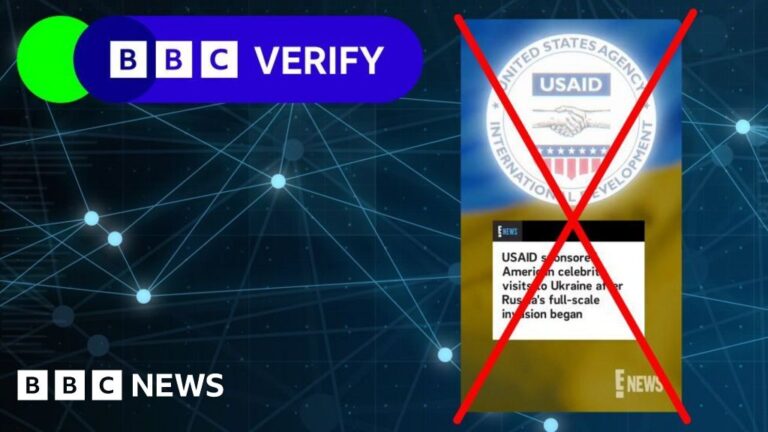Debunking the Myth: Hollywood Stars Paid by USAID to Visit Ukraine
In the digital age, misinformation can spread like wildfire, often blurring the lines between fact and fiction. A recent wave of false claims suggests that some Hollywood stars were financially compensated by the U.S. Agency for International Development (USAID) to visit Ukraine. As these allegations circulate, it is essential to sift through the chaos and separate reality from rumors.

The Origins of the Claim
The rumors began circulating on social media platforms and various conspiracy theory websites, claiming that celebrities such as actor Ben Stiller or filmmaker Sean Penn were being paid by USAID to endorse Ukraine’s political landscape amid the ongoing conflict. However, these claims lack substantive evidence and seem to stem from misunderstandings about the role these stars are playing in humanitarian efforts rather than any secret transactions.
According to a 2021 survey by the Pew Research Center, about 53% of Americans have encountered false or misleading information on social media platforms. This growing trend has heightened the importance of verifying news before sharing it.
Purpose of Visits
It is critical to understand why many celebrities have traveled to Ukraine. In the wake of the Russian invasion, numerous public figures have made their way to the country to show support and raise awareness about the humanitarian crisis affecting millions of Ukrainians. Their visits are not financially motivated, but rather rooted in compassion and urgency to help a nation struggling for survival.
For example, actor and director Sean Penn visited Ukraine shortly after the invasion in February 2022, working on a documentary while assessing the humanitarian situation firsthand. Penn’s commitment was clear as he announced that he would donate $1 million to relief efforts in the region.

USAID’s Role in Ukraine
USAID has been actively involved in Ukraine long before the war began, focusing on enhancing governance, supporting economic reforms, and bolstering democracy. Their efforts intensified following Russia’s annexation of Crimea in 2014. As part of their strategy, the agency provides humanitarian assistance, significantly contributing to the fight against poverty, further exacerbated by the current war.
In fiscal year 2022 alone, USAID allocated nearly $4.8 billion for humanitarian assistance to Ukraine. This funding goes towards food, shelter, medical aids, and rebuilding infrastructure. Thus, intertwining celebrities with allegations of receiving payments from USAID muddies the water surrounding the real objective: to assist people in need.
The Celebrity Influence on Humanitarian Aid
While the idea that Hollywood stars are funded by USAID may seem outlandish, the truth is that celebrity involvement can have a tangible impact on public awareness. A report from the Global Citizen organization indicates that 88% of people say that celebrities can influence issues such as poverty and disaster relief.
When celebrities publicly support humanitarian causes, they mobilize their extensive fanbases. The added publicity encourages donations, drives volunteers, and attracts media attention to critical issues—enabling organizations like USAID to maximize their outreach.

Challenges of Combating Misinformation
As the digital landscape becomes more chaotic, combating misinformation continues to be a challenge. Celebrities, influencers, and public figures must navigate scrutiny and speculation, despite their best intentions. Social media platforms have implemented measures to reduce the spread of false information, but it’s not foolproof.
A study by the Knight Foundation found that approximately 69% of Americans believe misinformation has cause harm to the country, highlighting the urgency for more robust measures to promote accurate information.
The Importance of Media Literacy
In light of these false claims, the significance of media literacy has never been clearer. Education institutions are increasingly focusing on teaching individuals how to critically evaluate sources, discern factual information from misinformation, and recognize potential biases.
Encouraging a culture of skepticism towards sensational claims can help stem the tide of misinformation. For the public, double-checking information and looking for credible sources can empower individuals to fight against the misinformation trend.
Conclusion
The notion that Hollywood stars were financial pawns in USAID’s agenda regarding Ukraine stands unfounded. These celebrities are genuinely committed to raising awareness and funds for a humanitarian crisis that requires urgent global attention. By providing support instead of succumbing to misleading narratives, they serve as catalysts for change in a time of dire need.
As the conversation about Ukraine evolves, it is essential to focus on facts over fiction, uniting for truth while extending our empathy to those caught in the conflict.

By equipping ourselves with knowledge and practicing media literacy, we can contribute to a more informed discourse about major global issues.


